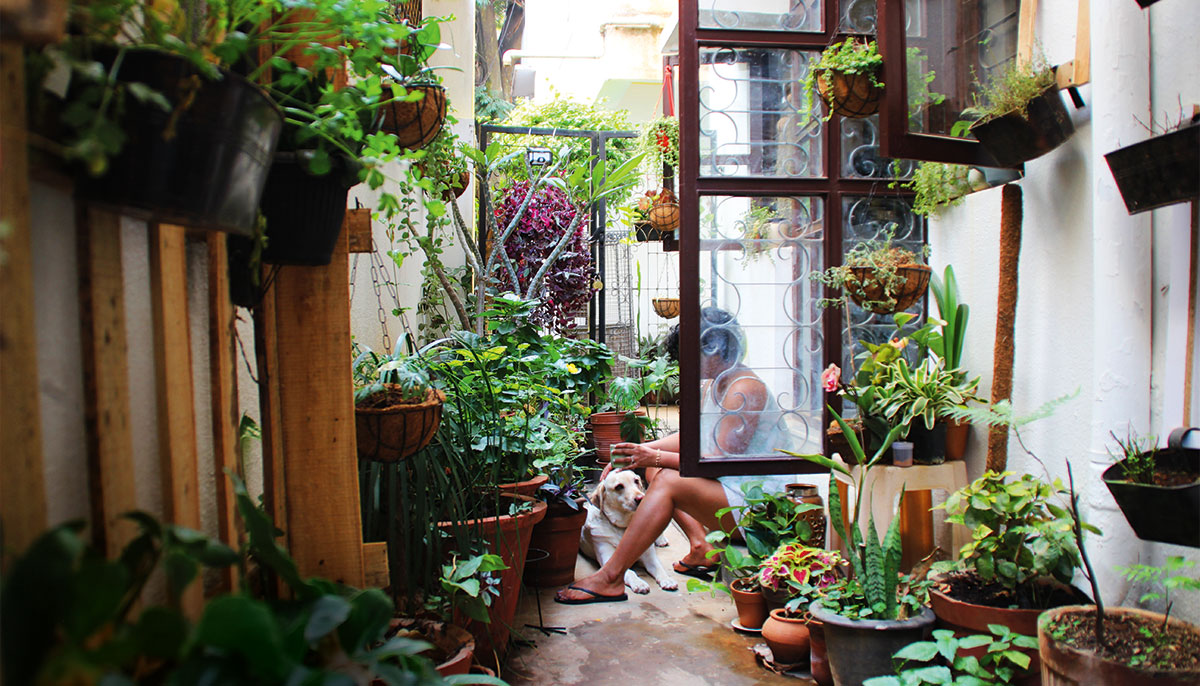What better place to practice mindfulness than in the garden? In the garden, we can let go of what others think of us, let go of trying to please other people, let go of judging our every action. Our flowers do not judge us. We can settle into our authentic selves. We’re home—our hearts are home.
Practicing mindfulness, we don’t need to improve our garden in any way. We are ordinary gardeners with ordinary gardens, and we’re doing the very best we can, given our resources of time, money, and other commitments. Let’s embrace the ordinary beauty in our backyard. Let’s tune into that happiness. Mindfulness is a forget-me-not reminding us to be here now.
The garden is an excellent sanctuary in which to wake up from the delusion we all live in.
The four foundations of mindfulness stake out the corners of our meditation garden. These practices of body, feelings, mind, and dhammas lead to the awakening of our heart-mind to the beauty all around us, even in difficult times.
While pruning bushes or raking leaves or planting seeds, settle into the body. This is first foundation of mindfulness. Perhaps we are familiar with mindfulness of the body from practicing breath meditation, walking meditation, or body scans. But in the garden, when we are in motion and doing lots of tasks, it’s easy to lose track of what the body is doing. Try simply being aware of each posture. By saying the labels aloud, you remind yourself of what you’re doing: walking from the flower bed to the compost pile; standing while you are watering a flowerbed; or bending over while you are weeding.
As you deadhead your flowers, you can practice the five daily reflections of aging, illness, death, impermanence, and karma. Say to yourself, “This flower is of the nature to grow old and die.” Notice the body walking to the compost bin. Pause for a moment and contemplate the life cycle of compost. Here today, gone tomorrow. Next year, new life springs forth. It’s a mystery.
Next, we move on to the second foundation of mindfulness, feelings, by which is meant mood or hedonic tone—not emotions. Go stand in one of your flowerbeds. How do you feel? Pleasant? Unpleasant? Or neutral? No need to go wandering off into story right now. Just, how do you feel? Accept the first word that comes to mind. No need to judge the answer. We’re scientists collecting data in this moment. There are no wrong answers.
Perhaps body and feelings, the first two foundations of mindfulness, are sufficient practices for you. Any one of the four foundations leads to awakening; you need choose only one. But analytic types tend to enjoy the third foundation: the mind. Watching the shenanigans of that rascal is a slippery object of meditation.
We begin our analysis of the mind by noticing the three roots of stress—greed, aversion, and delusion. If you like typologies, this is a very useful one. The so-called greedy type of person wants more of the pleasant; the so-called aversive type wants less of the unpleasant; and the deluded type (which is all of us) is confused by this idea.
Walk around your garden and again label everything your eyes land on as pleasant, unpleasant, or neutral. But this time, notice which category gets the most hits. Keep the judging mind at bay. You simply want to see if you’re tending toward greed, aversion, or delusion, because in that way you’ll know which antidote to apply. That is, you’ll know which practice will especially benefit your mind, making it more flexible.
Practice generosity for the greedy type, loving-kindness for the aversive type, and wisdom for the delusional type. Generosity might mean giving away bouquets of your flowers or giving your time to help a friend in her garden. Loving-kindness is something we can practice in every step, watering our minds with loving-kindness and goodwill. Wisdom comes from reading dharma books or articles and by surrounding ourselves with spiritual friends who keep us on the path, especially when our unkind habits of mind want to take us into the ditch. With these practices, we let go of the well-worn habits of mind.
Another helpful use for the greedy, aversive, and delusional typology is that these types lead us toward the recognition that the five hindrances prevent our minds from flowering with mindfulness and goodwill. The five hindrances are sense desire, ill-will, laziness, restlessness, and doubt. Sense desire wants more and better—more and better flowers, gardens, vegetables. Ill-will notices what’s wrong with the garden and is quick to judge the gardener. Laziness intends to garden or meditate but doesn’t get around to it. Restlessness includes anxiety, worry, and distraction. Doubt doesn’t trust the mind, the garden, or the gardener, so we doubt that we’re gardening properly.
Finally, we practice the fourth foundation of mindfulness, the awareness of dhammas, or phenomena—that is, everything, all of nature. When we’re outdoors in nature, attending to our plants, dhamma is there. Sitting in the calm of the garden, can we let the trees teach us about accepting life just as it is in this very moment? Can we take mindfulness with us wherever we go and bring curiosity to the investigation of nature all around us?
The garden is an excellent sanctuary in which to wake up from the delusion we all live in. We cultivate the conditions for awakening simply by stepping into the backyard and whatever garden we may have there. Finding the energy to garden or to meditate, we concentrate on the task at hand, even if we’re just sitting on a garden bench. We immerse ourselves in the joy the garden brings us. Mindful of body, feelings, mind, and nature, we walk step-by-step toward the joyful, calm, and kind mind that feels at home in the garden and in the world.

